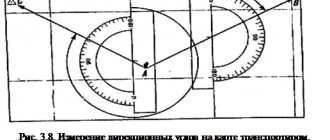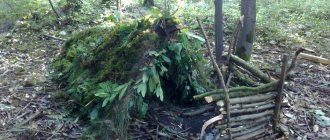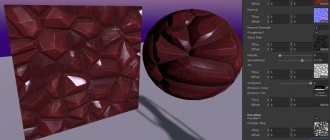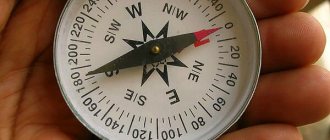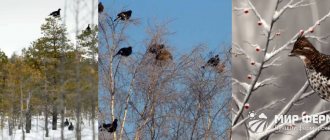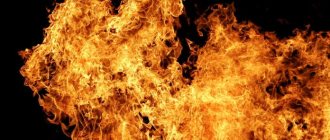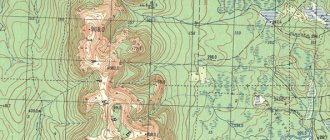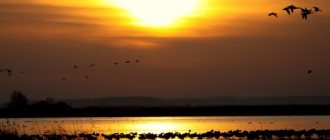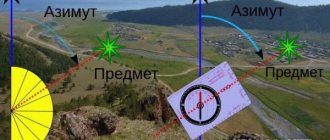Basic functions and requirements for a bivouac
From the definition it is already clear that a bivouac is a place where a tourist can relax in the open air and gain strength to continue his journey. If tourists do not have timely and quality rest, then in the future they will make mistakes.
In tourism and far from civilization, even the slightest mistake can become a serious problem, and sometimes even the cause of accidents. That is why rules and instructions have been developed for organizing parking in different areas, in all weather conditions.
A proper bivouac setup allows you to:
- cook food;
- dry clothes and other things;
- discuss the future route and plan;
- wait out inclement weather;
- arrange a long and safe stop with the opportunity to stay overnight.
An organized bivouac must meet all safety requirements even in the most extreme conditions.
Compliance with the developed rules and recommendations will allow you to build and maintain a fire even in heavy rain, protect against snow melting or rockfall if the path lies through the mountains, and in winter travelers will be able to warm up. An organized bivouac must meet all safety requirements even in the most extreme conditions.
Determining the location of the main elements of the camp and its staging
The convenience, comfort and safety of those who will be in it depend on how the camp is planned.
The place for the fire should be located on the downwind side in relation to the tents, so that the smoke is carried away in the direction opposite to the resting place. It should be convenient for preparing and eating food, drying things and heating, and also organized in compliance with fire safety rules.
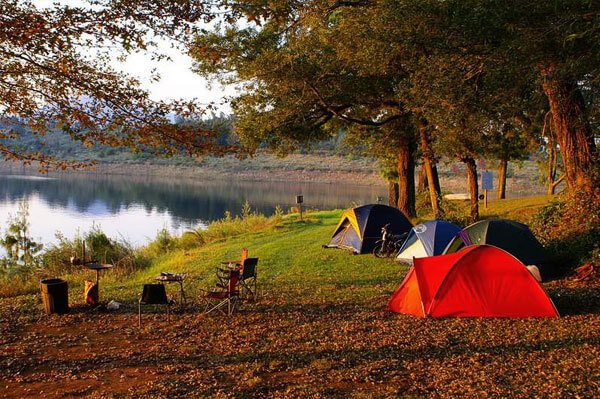
A specially organized place for tent camps.
The distance from the tents to the fire should be sufficient so that the fire does not scorch the fabric of the tent, but not so much that you have to run across the entire camp to the fire: this is, at a minimum, inconvenient. If, instead of tents, a lean-to hut is used, a fire can be built near it: this is how some hunters in the winter taiga warm themselves.
Separately, you can learn how to choose a place for a fire and organize the fire itself...
If there are a large number of participants in the hike and there is a large, flat area convenient for setting up tents, the tents can be placed in a circle with the entrances to the center. This will allow camp participants to communicate with each other more easily. However, it is perfectly acceptable to place tents in rows to save space. This will allow you to set up a bivouac even in a relatively narrow place, for example, in a ravine.
However, in difficult conditions, tents can be placed regardless of their position to each other, but so that each of them is on a fairly level and safe place. This is especially true if you need to set up a bivouac in a mountainous forest area, on loose land or moraine, where there are not so many flat areas.
It is advisable to place tents so that there is enough free space between them, and a passing person does not trip over each guy rope stretched from the tent.
The tent entrance is oriented depending on the conditions. For example, the entrance of the tent can be directed towards the river flowing near the bivouac, which increases the aesthetics of staying in the camp. Or the entrance to the tent can be located on the windward side so that the tent is well ventilated and it is not hot in it.
In any case, the entrance to the tent should ensure ease of use, as well as the safety of people. For example, it is unacceptable to place a tent on the edge of a cliff with the entrance to this very cliff, despite the beautiful views that open to the eyes of the residents.
If necessary, an awning can be pulled up in the camp so that the whole group, regardless of the weather, can gather under it and discuss important issues, or simply sit down to eat. Here it should be convenient for those on duty to organize meals for the hiking group. The photo shows such an awning over a fire pit:

In general, if the camp is placed correctly, it should be convenient to work and relax comfortably. This is true for tourism, and for fishing or hunting, but a tourist bivouac usually must be organized in compliance with the greatest number of requirements, both because of extreme situations and because of the distance from human habitation.
In many cases, tourists can choose a hiking route so that, based on known data about the area, they can initially plan the placement of bivouacs in suitable places indicated on the map, or at least so that at the end of the walking day they go to an area convenient for setting up camp - on the river bank , to the edge of the forest, to the well.
Bivouac equipment
Avid and experienced tourists have developed the minimum necessary set of equipment that will come in handy along the way.
- Bedding takes up the largest part. A sleeping bag and sleeping mat will ensure a good sleep, and a tent will protect you from wind, heavy rain or even snow, from wind and insects.
- The second necessary part is equipment for organizing a fire and cooking food. The group must have at least 1 ax or saw. They will allow you to prepare firewood and brushwood. You can use matches, a lighter, or a flint as a means of ignition. It is permissible to use auxiliary means - ignition, and candles or plexiglass are indispensable when starting a fire in the rain. To cook food, you will need a pot and a knitting needle with hooks that will hold the container above the fire. Gloves for hot removal are optional, but if you have some free space, it is better to take them.
- Personal belongings are a spare set of clothes and shoes, personal hygiene items, and a minimal first aid kit.
Attention! Also, every tourist should have a bright flashlight, map and compass in his backpack.
When going on a trip with a group, you can distribute inventory among yourself. This will avoid overload. With experience, you will be able to determine which things you can do without.
Cooking
Most often, tourists carry food with them in backpacks, so there is no need to waste time replenishing it, as is the case with water. For this reason, cooking food usually happens as an afterthought. As a rule, this is done by the attendants.
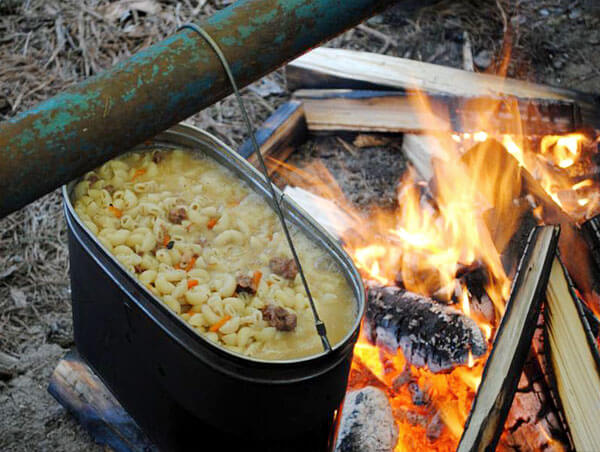
Often, by the time field cooking begins, the main work for the camp has already been done, and each participant can take care of himself (carry out hygiene procedures, relax or communicate with other participants in the hike), although this time can also be spent usefully, for example, replenishing firewood, going for berries and mushrooms, if conditions permit. But most often the camp is set up in the evening, and it is not possible to do anything else other than basic bivouac work before dark.
The criterion for the successful completion of this stage of bivouac work can be considered the satisfied faces of the participants in the hike, consuming with appetite the dinner cooked over the fire.

A bivouac in the dense taiga, where the water source is quite far away and we had to carry water in special containers.
This is all just an example of actions and the sequence of their implementation for an ordinary tourist group hiking in a temperate climate zone. The procedure and the actions themselves may differ from those indicated here depending on the presence or absence of certain resources and equipment, as well as on the conditions in which people are located.
Choosing a place for bivouac
The comfort and safety of tourists depends on following simple rules for organizing a bivouac. When choosing a location, it is recommended to rely on the following criteria:
- safety - the environment should not threaten human health and damage equipment;
- comfort, which depends on the possibility of carrying out work and organizing a recreation area in the same place;
- visibility - the selected site should be visible from air and sea in the event of a bivouac organized by victims of an accident;
- aesthetics - a beautiful opening appearance will significantly improve mood and performance.
Pay attention! Availability of natural resources and other criteria should be considered when selecting a site.
Components of a bivouac
A standard bivouac consists of two main elements: a place to sleep and a site for making a fire. They may be located at some distance from each other, and sometimes the tents are placed around or next to the fire.
Additionally, trekking participants can add to their bivouac an area for storing and drying firewood, drying things, a place for group gathering or training.
If a large group goes on a hike, then a place for a toilet, and sometimes even a shower, is organized. The list goes on and on. It all depends on the goals of the trip, the wishes of the participants, equipment and gear.
Presence of trees nearby
It is best to organize a camp in a forest where there are trees nearby. They serve for tourists:
- fuel for the fire;
- natural wind protection;
- some trees provide travelers with nuts and fruits;
- if there is military action nearby, they serve as protection.
However, there are also negative points:
- In winter, snow may fall from the branch;
- in a hurricane, trees pose a threat;
- if the bivouac is organized in a situation where the group has suffered an accident, then the trees will prevent the group from being detected;
- In summer, there is a possibility that a tree will be struck by lightning.
Preparation of kindling brushwood, firewood and lighting a fire
In some cases, materials for organizing a fire are collected along the way. For example, you can pick birch bark or collect smog for ignition. They don't take long to assemble, and they can easily fit in your pocket. At the same time, such insignificant things will significantly reduce the time for ignition, because the site chosen for parking does not always have good material for kindling.
In large groups, there is often a designated person in charge of starting the fire. However, you should not place the task of collecting brushwood and firewood on a person. Collective collection will reduce the search time and speed up the appearance of the desired flame.
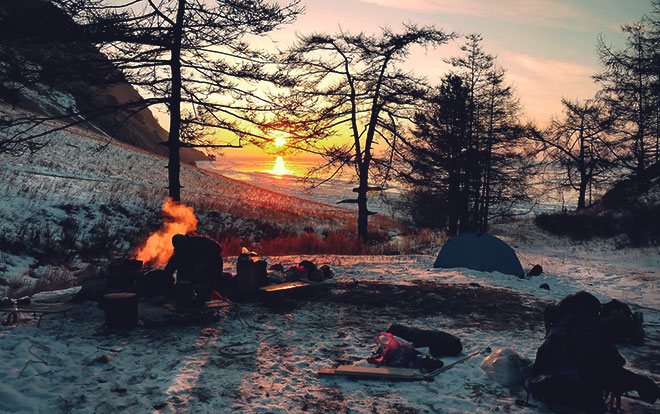
Bivouac in winter.
The preparation stage can be considered completely completed when there is enough material to maintain a heating fire, as well as for cooking food and tea.
Relief and other terrain features
To organize a bivouac, choose a dry and level area. However, if necessary, you can arrange parking in swampy areas. It will allow you to hide from danger and remain unnoticed.
It is much easier to organize a bivouac on flat terrain, but if heavy rain is expected during the hike, then sloping terrain will avoid water accumulation. Additionally, tents can be dug in with a ditch. This will prevent the formation of puddles under the sleeping areas. When organizing a camp in a wooded area, select an area with a minimum amount of pine cones and brushwood. This will reduce the time it takes to clear the site.
Organization of bivouac work
Next, take care of the inside of the tents. These can be sleeping bags or air mattresses with blankets. Both have their pros and cons. After sleeping, it is better to take out the insides of the tent and leave them in the sun. Things will be dry and warm.
Having dealt with the tents, proceed to creating a fireplace. There are many options for creating it. If you need to cook food quickly, use a star-shaped hearth arrangement. Arrange the logs like sun rays. This will create heat and a large surface for dishes. If you need to quickly warm up, build a tent out of logs. This will produce a large, hot flame. There are many campfire options.
We recommend reading:
Sights of Venice
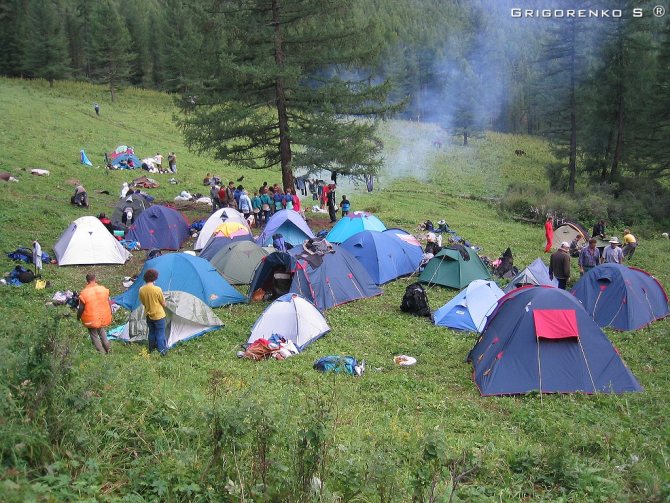
Camping
Build a clothes dryer next to the flame. Do not place it too close or low above the fire. As you work with the fire, make sure it doesn't get too hot and the flames don't spread to dry grass. This is especially true for dense areas. At night, it is better to fill the fire with water or leave a person on duty next to it. It is better to collect logs for the fire in advance for the whole night; searching for logs at night can take a long time and cause inconvenience.
Build a table for eating and benches. If you did not take what you need in advance, you can use logs and build a table from scrap materials.
Build a toilet for the bivouac, it is better to do this at a decent distance from it, deeper in the bushes. After its disposal, it is necessary to disinfect the area and remove debris. It is better to scorch the garbage in a fire and bury it so that it decomposes faster. If possible, it is better to pick it up.
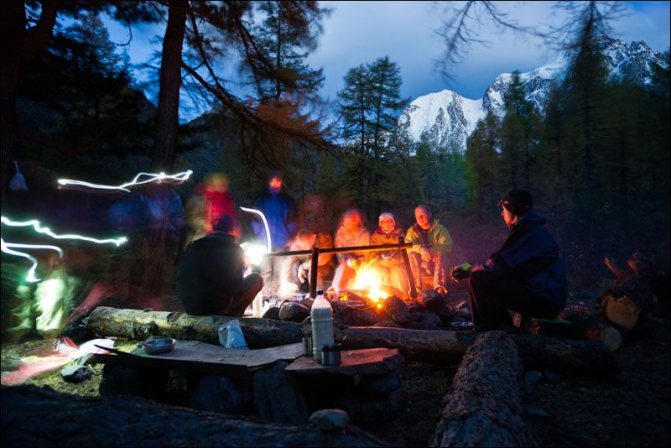
Cozy bivouac
When to start looking for a place to camp
It is recommended to search for a place to organize a vacation during the day. Minimum - 2 hours before sunset. This time should be enough to collect brushwood and firewood, set up tents and make a fire. However, times may vary:
- depending on the convenience of location and surrounding area;
- the need to make a fire (in some hikes it is replaced by a burner);
- the need to install tents (when organizing a bivouac for participants in an accident, places to sleep have to be built from improvised means, which takes additional time).
Note! Even with a flashlight, organizing a parking space in the dark is quite difficult.
Bivouac on ski trips
Holidays in winter are quite specific. This is due to the presence of snow, as well as low temperatures. The equipment of tourists is increased due to the need to use two-layer tents with a vestibule, portable stoves and other equipment.
Before a planned halt, the speed of movement must be reduced so that the body temperature can adapt to weather conditions. When taking off your backpack, it is recommended to wear a down jacket.
You must clear and trample down the selected area without removing your skis. Persons responsible for lighting the fire are sent to collect brushwood and clear the area for the fire.
Tourists often negotiate accommodations for the night with residents of nearby settlements, but if this option is not possible, then one large hole must be dug for an overnight stay and a fire. Its walls are laid with spruce branches, which will reflect heat from the fire and keep it inside the walls of the pit, warming tourists.
Note! When setting up a bivouac in a deciduous forest, skis are stuck in a circle, onto which blankets and rugs are attached. They will serve as spruce branches.
Bivouac in rally raids
The organization of overnight accommodation most often takes place near airfields or in a special designated area. Often, parking is organized in the same places. This will save the mechanic from having to move every day and allow him to rest peacefully.
Bivouac on ski trips
Snow cover and low temperatures determine the specifics of bivouacs for ski tourist trips. Equipment is prepared by skiers in advance: two-layer insulated tents with a vestibule, portable stoves, equipment for cooking and heating.
Before any rest, skiers should reduce their speed so that their hot body can slowly normalize its temperature. Having stopped at a small rest stop, you need to immediately take off your backpack and put on a warm down jacket. It would be advisable to eat a glucose tablet, a piece of refined sugar and drink some hot liquid stored in a thermos. After 10 minutes, the body may begin to feel cold, so you cannot take a short rest longer.
A big halt should also not be made long. The most important thing with him is to quickly distribute all responsibilities between tourists. Any delay can lead to hypothermia. First of all, some hikers, without taking off their skis, trample the area in the snow, while others carry firewood and make a fire. The area for the fire is raked with special collapsible shovels, which can also be useful for fanning the fire. Food should boil quickly. Here you can melt water from the snow.
Usually skiers spend the night in populated areas, having agreed in advance with the owners of local organizations. But sometimes tourists have to build a barrier in the forest for an overnight stay using improvised means. It’s good if there is fuel nearby, and the overnight site itself is sheltered from the wind by a dense spruce forest or hill (a fold of the terrain). If you have a saw, you should start felling and sawing dry spruce/pine immediately. If you only have axes, you will have to get a lot of dry branches and dead wood, the fire of which requires a lot of effort.
Digging a pit for a fire and lodging for the night is very labor-intensive: it must fit the fire and all the tourists lying down. You will need a lot of dry spruce branches, which will be used not only for the flooring, but also for the sides of the barrier - a special wall that reflects the heat of the fire onto sleeping tourists. The frame of the barrier is made of poles, and spruce branches are placed on them. The barrier is covered with snow on top.
If the bivouac takes place in a deciduous forest, then a barrier is constructed from skis - they are stuck into the snow and blankets are secured to them using ski poles. The bottom of the blankets is sprinkled with snow.
How to set up a bivouac in extreme conditions
In extreme conditions, it is necessary first of all to rely on safety principles when setting up a bivouac. Thus, tourists will be able to fully relax and continue with renewed vigor. In extreme conditions, a dug hole or dugout is the best place to spend the night. It will protect from rain, wind and natural disasters.
In the taiga you cannot do without a down sleeping bag, but if you don’t have one at hand, it is recommended to find snow shelters such as holes, trenches or even dens.
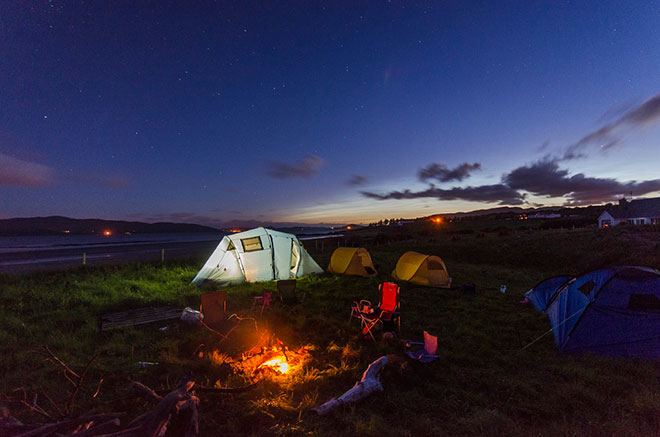
In the coastal area, choose the highest possible location, taking into account the river flood.
When going on a hike, it is better to take a tent with you. It is the best shelter from bad weather.
Bivouac in rally raids
Participants are usually accommodated in convenient locations, near airfields or directly on their territory: during rally marathons, many journalists and equipment have to be transported by air. It is very convenient when bivouacs are organized in the same places: mechanics do not have to move every day, and service teams can relax after work.
Before the first participant in the race arrives at the destination, the bivouac must already be fully organized and include all amenities (shower, toilet, food). Marathon participants determine their own overnight accommodation, usually using tents or trailer houses.
What is a “Bivouac” or how to spend the night in the forest?
10-01-2011
A bivouac is a resting place where they rest, eat, and spend the night. On one-day hikes, only large lunch breaks are arranged. If there are lying tree trunks at the resting place or near it, “sofas” can be built on them: a plastic tablecloth or oilcloth is laid out on a flat area, and logs are placed around it (thicker ones downwards, and thinner ones on them perpendicularly). On two-day or longer trips, they spend the night in bivouacs.
The main requirement for a bivouac - safety - is easily met in central Russia. It is more difficult to choose a place that is convenient and, if possible, picturesque, with water and firewood available. In autumn, winter and spring in the middle zone, firewood is more important, and in summer - water. It is undesirable to stop on the river bank below large villages downstream, near bodies of water with standing water, near industrial enterprises, roadways, and power lines.
The bivouac is located well if it is set up in a picturesque place, covered with forest, preferably a spruce forest, with convenient approaches to water, good firewood nearby, the place is protected from the wind in winter and ventilated in summer (in hot weather, in the presence of mosquitoes). It’s not bad if the tents can be stretched between the trees. There should be no dried out, rotten trees near the bivouac: they can fall on people, a fire, or a tent. In winter, there must be dead wood or dead wood near the bivouac site.
In winter you need to stop before dark, then it is easier to choose and cut sushi. Work on the bivouac should take the minimum possible time. The faster they are completed, the more time will be left for rest and movement, i.e. the hike itself. However, you cannot save time at the expense of the quality of work, ease of rest, or reduction of sleep.
Each of the works at the bivouac is performed by the participants who are entrusted with it, and individual types are performed by those who specialized in them. If some work is harder than others, it is better for everyone to do it one by one (for example, preparing firewood for a winter night by the fire).
If the hike will last several days, and the conditions are expected to be approximately the same, the work should be distributed in advance so that all participants go through all types of work. For example, today two people are on duty - lighting and maintaining a fire, working with a stove or primus stove - preparing food; tomorrow they prepare fuel (“loggers”), and the day after tomorrow they set up tents (“house builders”).
Work at the bivouac must be distributed in advance or immediately upon arrival at the site. The order of work depends on the type of tourism, specific conditions, number and experience of people in the group. If there is little dead wood and fallen trees at the bivouac site, more people are sent to collect firewood; if rain is approaching or is already falling, they immediately set up tents. During a water voyage, the vessels are first unloaded and brought ashore. The priority work in the winter is collecting firewood, setting up tents or equipping a place to stay overnight (awnings, flooring).
In general, it is advisable to carry out all work on the bivouac simultaneously. Setting up camp from the moment the group stops until the end of all evening work lasts no more than two hours, and sometimes no more than an hour and a half, which is quite good. The same amount of time should be spent winding down camp in the morning (from getting up to leaving).
Those on duty who prepare food in the morning get up 0.5-1 hour before the general rise. Kindling, firewood, food, and water are prepared in the evening. Firewood must be protected from rain or dew at night, and water must be prepared in the evening (in winter, and if it is far away, then in summer).
Having chosen a place for bivouac, decide where the fire will be, if it is planned, then immediately determine a place for tents. Place tents no closer than 5 - 6 meters from the fire so that sparks cannot get on them.
For fires, try to find already trampled places, old fire pits. If there are none, remove the turf at the site of the proposed fire with a spatula (which is recommended for such cases). Before leaving, place the sod in its original place and water it with water. The fire should be no closer than 5 - 6 meters from trees and bushes. You cannot make fires in young coniferous forests, dense bushes, on a pile of dry branches, near stacks of hay, straw, on peat bogs, or near buildings.
The fireplace must be protected from the wind. Fanning the flame, the wind can set fire to grass, brushwood, and dry leaves. Fire spreads very quickly through dry grass. In winter, in the forest, a place for a fire is chosen so that the warm stream of air does not reach the snow-covered branches. Otherwise, when the fire flares up, rain from the Kukhta snow melting on the branches will pour down on it and the people standing nearby.
The best fuel for a fire is dried standing spruce and pine. Good dry deciduous woods are rare, as they quickly rot. Dry coniferous trees are protected from rotting by resin, but it is easy to make a mistake with dead pine: dead pine may not have time to dry and will burn poorly. In a deciduous forest it is difficult to find good firewood for a large fire, which is necessary for a warm night in winter.
To use dead trees, you must first obtain permission from the forestry enterprise or forestry department subordinate to it, in the forests of which you are going to spend the night.
There is no need to fell large dead trees unless absolutely necessary, even if you have a permit: this is labor-intensive and dangerous work. Thick logs for a fire are only required in winter.
When cutting wood, place a log or log over it. There is no need to chop wood on the ground or rocks. It is not advisable to hold the log you are cutting with your foot, since your foot is close to the point of impact.
It’s better to make a fire like this. First, light the kindling - birch bark from fallen or rotten birch trees, paper, a thin dry splinter, thin dry branches. Light the kindling from below, then it will all burn. It will set fire to thin dry branches, chips, and splinters, which are good to lay in a hut. Place thicker branches on them. Gradually add thicker branches and firewood. There must be a gap between the branches, splinters and firewood for air access so that the fire burns well. If you put fuel very tightly into a fire that has not yet lit, the fire may go out.
At the beginning, all fuel must be dry, otherwise it will not burn: there is not enough heat yet to dry and ignite damp wood. Do not put too thick wood on the fire prematurely: it may not have time to ignite (and there is not enough heat here), and the burning thinner branches will already burn out. Gradually increase the thickness of the wood and you will get the desired fire. Once coal forms in a fire, it will not go out easily. Gradually adding firewood, maintain the required fire intensity.
To make a fire in the rain, you should have artificial kindling: pieces of plexiglass, photographic film, a piece of candle, dry alcohol tablets. You can use shavings for kindling, since even dry pine branches are damp on top when it rains; the shavings will easily catch fire from the kindling. Split the thicker branches: they are dry inside. Stretch an awning over the fire or have someone hold a piece of film over it until the fire burns.
First, fold the fire into a hut, since this way the fuel is better protected from moisture from rain. Place firewood that does not immediately go into the fire on the sides, also in a hut, so that it dries out and protects the fire from rain. Cover the remaining firewood with film or stack it under the protection of an awning or tree needles.
Some tourists, having gotten wet while trekking in the rain and hastily pitched their tents, climb into them and don’t want to get out in the rain anymore, preferring not to even cook food and lie gloomily in their tents. Don't be lazy to light a fire in the rain. This will immediately improve the mood of the team, provide an opportunity to prepare food, dry things, warm up and have a normal rest.
In winter, in the snow, a fire must be built on a lining of damp dead wood. If the snow is not deep (up to 30–40 cm), it is better to clear the area to the ground.
Even in winter, you can spend the night in the forest area without a tent near the fire. For such an overnight stay, a fire made of 3 logs 1.5 - 2 m long and 35 cm in diameter is best suited. They make it on the ground, clearing the snow, if it is not very deep. Then they make the flooring using small dead wood. If you do not clear the snow to the ground, the flooring should be more durable. First, you need to place damp and rotten logs across the future fire, then along it. Without a covering, the fire will fall into the melted snow.
Small brushwood placed across their length is lit on the two lower logs. It is good to pre-score these logs so that they light up better. The third log, the largest, is placed on burning brushwood.
Dry resinous logs ignite quickly from the sides facing each other. As it burns, the top log lowers, automatically adjusting the intensity of the flame. The lower logs burn more slowly and must be moved from time to time. If the heat is too much, you can raise the upper logs on supports (put two damp branches across the lower logs at their edges), and move the lower ones apart. The larger the gap between the logs, the weaker the fire and the slower the fire burns. The top log, with a thickness of about 30 cm, is enough for 3-4 hours, then it is replaced with a new one. Lower logs burn slower.
Leave enough firewood for the morning. There must be a hot fire in the morning, otherwise getting ready will be unpleasant and long. Before leaving, the logs of the fire are extinguished by rolling them out in the snow. You can then stand them upright, leaning against each other or against stumps. Then others can use the logs.
Metal equipment is used to hang dishes over the fire. The hearth or supports for the crossbar can also be built from large stones stacked on top of each other. If there is only one bucket above the fire, you can stick a pole at an angle into the ground, support it with a flyer, a stone, or a stump and hang the bucket at the end above the fire.
A fire contains potential danger, so the manager should definitely appoint a fire watcher, who will monitor it the entire time it is burning and supervise its extinguishing.
Excessively large fires are harmful and unnecessary: they consume a lot of wood, you cannot cook food on them, and you cannot dry things around them. In addition, with a fire “to the skies”, dry trees standing to the side can catch fire; shooting firebrands can set fire to grass and brushwood far from the fire. This fire is getting out of control.
When leaving the bivouac site, you must fill the fire with water, even if only smoldering firebrands and coals remain. The main cause of large forest fires was and remains poorly extinguished fires. Careful handling of fire should become a habit for tourists.
Tents and huts can be erected without first fixing the floor. Before setting up the tent, it is advisable to zip it up, otherwise it is easy to tighten it in width or height. When tightening the ridge guy ropes, you should strive to ensure that the end of the tent, the poles and the pegs to which the guys are attached are on the same straight line. The direction of the corner guy lines on the wings of the tent should not be in line with the edge of the side slope, but should be diagonal.
Tents should be well tensioned, especially the roof. If it is going to rain or snow, the tent should be covered with an additional awning and secured well. Tents made of tarpaulin or other waterproof material also need an awning, despite the fact that their slopes are located at a large angle to the ground and snow, if water easily drains from them.
When the awning is well stretched, it protects the tent from rain, even if the fabric is waterproof. An awning is also useful in winter when there is no precipitation, because tents with an awning are less likely to freeze (the difference between the outside and inside temperatures is smaller). Especially if it snows. Snow, freezing on the tent, makes it significantly heavier, and it is easily shaken off the awning. It is very difficult to clear a tent from external icing and internal drizzle while camping and is completely possible only with prolonged drying, which requires a lot of time and a large fire.
To set up tents, light metal poles and light pegs made of rod, aluminum corners or plastic are used. Tent poles can be duralumin tubes with a diameter of 10–15 mm. You need to take three pieces of pipe onto the rack. Wooden plugs are hammered into one of the tubes on both sides, onto which the other two are placed. In various forms, these six tubes, 40–45 cm long, can be carried laid down with the tent.
To carry the tent in a backpack, it is better to roll up the tent not in one roll, but in two, towards each other, or fold it into a rectangular bundle.
Large tents usually do not have a floor. This has its advantages, which we will talk about later. Installing such tents is not difficult, but it requires, as in any business, a certain skill.
Such a tent is supported by a central stake 190–200 cm long. Guys are usually attached so that the area inside the tent approaches the shape of a circle, unless there is an intention to stretch it into an oval, which is sometimes more convenient for placing people.
Installation of the tent begins by pulling its top onto the central stake. The tourist, holding the stake, stands inside the tent and comments: he can clearly see what shape the tent takes when tensioned. The vertical part of the walls usually has extra length or folds, which can be pressed from the inside with sleeping bags or backpacks, without specially fixing them. The existing loops allow you to secure the tent with pegs along the bottom edge more clearly.
A large tent can be heated in winter with a hanging or floor stove. The fuel for it is logs about 20 cm long, chopped from dry logs. A small amount of sushi is enough for 10–12 hours. Continuous burning. And when using a floor-standing stove, specially adapted for cooking, there is no need for a fire set. An hour after stopping, the group can already rest in a warm tent. With such a warm overnight stay, people rest more fully and with greater comfort. With a floor-standing stove, it’s enough to find one drying rack in a place suitable for spending the night - and you can set up a bivouac.
In treeless areas you have to take camp stoves with a supply of gasoline, and less often, gasoline or gas stoves. If you cook food on primus stoves in a large tent, then even in winter, when it’s frosty, it will have a positive temperature. For primus stoves, a special corner is set aside in the tent - a kitchen, above which it is advisable to have a small canopy above and on the sides. In the tent where the stove is heated or primus stoves are used, a hole is made in the upper part for ventilation, smoke and water vapor to escape. At night in severe frost, the holes are closed by tightening the sleeve sewn into it.
When using stoves and primus stoves, safety precautions must be observed. The pipe from the stove passes through a hole in the roof or wall of the tent. Around the pipe, 15–20 cm of the tent fabric is replaced with non-flammable asbestos or fiberglass fabric. A spark arrestor - a deflector - is placed on the pipe outside the tent. You cannot use stoves in tents made of nylon fabric: even with spark arresters, a small part of the sparks can get on the nylon fabric and burn it.
Primus stoves and gas burners must be carefully adjusted before the trip. On the route, their work is always monitored by the participant who regulated them. He must teach the rest of his companions how to use primus stoves and gas burners.
It is advisable to light primus stoves outside the tent or, as a last resort in winter, in the “kitchen”, behind the canopy.
As we have already said, cutting spruce branches even for one night’s stay is unacceptable. Instead, place it on the ground, cleared of twigs, stones, and cones, and in winter, on trampled snow with plastic film. Lay foam mats or a camping mat in the tent (in winter, a mat on top of the mats), and then lay out the sleeping bags.
Break up the camp; participants, except those on duty, can pack their things before breakfast. When breakfast is ready, all work is interrupted so as not to delay the attendants and the exit in general. It is advisable that the buckets after meals are washed by those on duty, since today’s people already have a lot to do.
Leave the bivouac in such a condition that others will want to stay here and will not have to clean up or find another place and re-equip everything. Burn metal cans over a fire, and then bury them, burn all combustible garbage, and put the remaining food in a secluded place - for the forest inhabitants. Glass jars to take back to town. Carefully stack the remaining firewood near the fire pit.
When leaving, inspect the bivouac to see if things have been forgotten. The bivouac is inspected by those on duty and those assigned to do so, otherwise everyone will rely on the other.
